Impact of Combined Modulation of Two Potassium Ion Currents on Spiral Waves and Turbulent States in the Heart
Abstract
1. Introduction
2. Materials and Methods
2.1. Mathematical Model
2.2. Numerical Methods
2.3. Initial State of the System
2.4. Control Methods
2.5. Measurement of Control Effects
3. Results
3.1. The Control Effects on the System at the Initial State of Spiral Waves
3.1.1. The Effect of Reducing the Maximum Conductance of Potassium Ions on Spiral Waves
3.1.2. The Effect of Increasing the Maximum Conductance of Potassium Ions on Spiral Waves
3.2. The Control Effects on the System at the Initial State of Turbulent States
4. Discussion
5. Conclusions
Author Contributions
Funding
Institutional Review Board Statement
Data Availability Statement
Conflicts of Interest
References
- Gerhardt, M.; Schuster, H.; Tyson, J.J. A cellular automaton model of excitable media including curvature and dispersion. Science 1990, 247, 1563–1566. [Google Scholar] [CrossRef] [PubMed]
- Davidenko, J.M.; Kent, P.F.; Chialvo, D.R.; Michaels, D.C.; Jalife, J. Sustained vortex-like waves in normal isolated ventricular muscle. Proc. Natl. Acad. Sci. USA 1990, 87, 8785–8789. [Google Scholar] [CrossRef]
- Gray, R.A.; Jalife, J.; Panfilov, A.V.; Baxter, W.T.; Cabo, C.; Davidenko, J.M.; Pertsov, A.M. Mechanisms of cardiac fibrillation. Science 1995, 270, 1222–1223. [Google Scholar] [CrossRef] [PubMed]
- Vandersickel, N.; Bossu, A.; Neve, J.D.; Dunnink, A.; Meijborg, V.M.F.; Heyden, M.A.G.; Beekman, J.D.M.; Bakker, J.M.T.D.; Vos, M.A.; Panfilov, A.V. Short-lasting episodes of torsade de pointes in the chronic atrioventricular block dog model have a focal mechanism, while longer-lasting episodes are maintained by re-entry. JACC Clin. Electrophysiol. 2017, 3, 1565–1576. [Google Scholar] [CrossRef] [PubMed]
- Nair, K.; Umapathy, K.; Farid, T.; Masse, S.; Mueller, E.; Sivanandan, R.V.; Poku, K.; Rao, V.; Nair, V.; Butany, J.; et al. Intramural activation during early human ventricular fibrillation. Circ. Arrhythm. Electrophysiol. 2011, 4, 692–703. [Google Scholar] [CrossRef]
- Davidenko, J.M.; Pertsov, A.V.; Salomonsz, R.; Baxter, W.; Jalife, J. Stationary and drifting spiral waves of excitation in isolated cardiac muscle. Nature 1992, 355, 349–351. [Google Scholar] [CrossRef]
- Fenton, F.H.; Cherry, E.M.; Hastings, H.M.; Evans, S.J. Multiple mechanisms of spiral wave breakup in a model of cardiac electrical activity. Chaos 2002, 12, 852–892. [Google Scholar] [CrossRef]
- Alonso, S.; Bar, M.; Echebarria, B. Nonlinear physics of electrical wave propagation in the heart: A review. Rep. Prog. Phys. 2016, 79, 096601. [Google Scholar] [CrossRef]
- Pan, D.B.; Gao, X.; Feng, X.; Pan, J.T. Removal of pinned scroll waves in cardiac tissues by electric fields in a generic model of three-dimensional excitable media. Sci. Rep. 2016, 6, 21876. [Google Scholar] [CrossRef]
- Yuan, G.; Xu, A.; Wang, G.; Chen, S. Control of spiral-wave dynamics using feedback signals from line detectors. Europhys. Lett. 2010, 90, 10013. [Google Scholar] [CrossRef]
- Gray, R.A. Termination of spiral wave breakup in a Fitzhugh–Nagumo model via short and long duration stimuli. Chaos 2002, 12, 941–951. [Google Scholar] [CrossRef] [PubMed]
- Li, W.; Janardhan, A.H.; Fedorov, V.V.; Sha, Q.; Schuessler, R.B.; Efimov, I.R. Low-energy multistage atrial defibrillation therapy terminates atrial fibrillation with less energy than a single shock. Circ. Arrhythm. Electrophysiol. 2011, 4, 917–925. [Google Scholar] [CrossRef]
- Zhang, H.; Cao, Z.; Wu, N.; Ying, H.; Hu, G. Suppress winfree turbulence by local forcing excitable systems. Phys. Rev. Lett. 2005, 94, 188301. [Google Scholar] [CrossRef] [PubMed]
- Majumder, R.; Feola, I.; Teplenin, A.S.; Vries, A.A.F.; Panfilov, A.V.; Pijnappels, D.A. Optogenetics enables real-time spatiotemporal control over spiral wave dynamics in an excitable cardiac system. Elife 2018, 7, e41076. [Google Scholar] [CrossRef]
- Bingen, B.O.; Engels, M.C.; Schalij, M.J.; Jangsangthong, W.; Neshati, Z.; Feola, I.; Ypey, D.L.; Askar, S.F.A.; Panfilov, A.V.; Pijnappels, D.A.; et al. Light-induced termination of spiral wave arrhythmias by optogenetic engineering of atrial cardiomyocytes. Cardiovasc. Res. 2014, 104, 194–205. [Google Scholar] [CrossRef]
- Pan, J.T.; He, Y.J.; Xia, Y.X.; Zhang, H. Control of spiral waves in excitable media under polarized electric fields. Acta Phys. Sin. 2020, 69, 080503. [Google Scholar] [CrossRef]
- Boccia, E.; Luther, S.; Parlitz, U. Modelling far field pacing for terminating spiral waves pinned to ischaemic heterogeneities in cardiac tissue. Philos. Trans. R. Soc. A 2017, 375, 20160289. [Google Scholar] [CrossRef]
- Hörning, M.; Takagi, S.; Yoshikawa, K. Controlling activation site density by low-energy far-field stimulation in cardiac tissue. Phys. Rev. E 2012, 85, 061906. [Google Scholar] [CrossRef] [PubMed]
- Gao, J.; Gu, C.; Yang, H. Applying a global pulse disturbance to eliminate spiral waves in models of cardiac muscle. Chin. Phys. B 2021, 30, 070501. [Google Scholar] [CrossRef]
- Bai, J.; Huang, Z.J.; Tang, G.N. Terminating arrhythmia by using motion controller. Chin. J. Comput. Phys. 2021, 38, 352–360. [Google Scholar]
- Chen, J.X.; Guo, M.M.; Ma, J. Termination of pinned spirals by local stimuli. Europhys. Lett. 2016, 113, 38004. [Google Scholar] [CrossRef]
- Yamazaki, M.; Honjo, H.; Ashihara, T.; Harada, M.; Sakuma, I.; Nakazawa, K.; Trayanova, N.; Horie, M.; Kalifa, J.; Jalife, J.; et al. Regional cooling facilitates termination of spiral-wave reentry through unpinning of rotors in rabbit hearts. Heart Rhythm 2012, 9, 107–114. [Google Scholar] [CrossRef] [PubMed]
- Li, Q.Y.; Huang, Z.J.; Tang, G.N. Eliminating spiral wave and spatiotemporal chaos in cardiac tissues by suppressing the rotation of spiral wave tip. Acta Phys. Sin. 2018, 67, 248201. [Google Scholar]
- Pan, F.; Li, W.X.; Wang, X.Y.; Tang, G.N. Terminating the spiral wave and spatiotemporal chaos in cardiac tissue using the low-pass filtering scheme. Acta Phys. Sin. 2015, 64, 218202. [Google Scholar] [CrossRef]
- Song, Z.; Qu, Z.L. Delayed global feedback in the genesis and stability of spatiotemporal excitation patterns in paced biological excitable media. PLoS Comput. Biol. 2020, 16, e1007931. [Google Scholar] [CrossRef] [PubMed]
- Isasi, I.; Irusta, U.; Aramendi, E.; Eftestol, T.; Kramer-Johansen, J.; Wik, L. Rhythm analysis during cardiopulmonary resuscitation using convolutional neural networks. Entropy 2020, 22, 595. [Google Scholar] [CrossRef] [PubMed]
- Braunschweig, F.; Boriani, G.; Bauer, A.; Hatala, R.; Herrmann-Lingen, C.; Kautzner, J.; Pedersen, S.S.; Pehrson, S.; Ricci, R.; Schalij, M.J. Management of patients receiving implantable cardiac defibrillator shocks: Recommendations for acute and long-term patient management. EP Europace 2010, 12, 1673–1690. [Google Scholar] [CrossRef] [PubMed]
- Kong, X.; Ravikumar, V.; Mulpuru, S.K.; Roukoz, H.; Tolkacheva, E.G. A data-driven preprocessing framework for atrial fibrillation intracardiac electrocardiogram analysis. Entropy 2023, 25, 332. [Google Scholar] [CrossRef] [PubMed]
- Cheng, E.P.; Liu, C.F.; Yeo, I.; Markowitz, S.M.; Thomas, G.; Ip, J.E.; Kim, L.K.; Lerman, B.B.; Cheung, J.W. Risk of mortality following catheter ablation of atrial fibrillation. J. Am. Coll. Cardiol. 2019, 74, 2254–2264. [Google Scholar] [CrossRef]
- Bohnen, M.; Stevenson, W.G.; Tedrow, U.B.; Michaud, G.F.; John, R.M.; Epstein, L.M.; Albert, C.M.; Koplan, B.A. Incidence and predictors of major complications from contemporary catheter ablation to treat cardiac arrhythmias. Heart Rhythm 2011, 8, 1661–1666. [Google Scholar] [CrossRef]
- Reilly, L.; Eckhardt, L.L. Cardiac potassium inward rectifier Kir2: Review of structure, regulation, pharmacology, and arrhythmogenesis. Heart Rhythm 2021, 18, 1423–1434. [Google Scholar] [CrossRef] [PubMed]
- Heijman, J.; Algalarrondo, V.; Voigt, N.; Melka, J.; Wehrens, X.H.T.; Dobrev, D.; Nattel, S. The value of basic research insights into atrial fibrillation mechanisms as a guide to therapeutic innovation: A critical analysis. Cardiovasc. Res. 2016, 109, 467–479. [Google Scholar] [CrossRef] [PubMed]
- Chen, M.; Xu, D.Z.; Wu, A.Z.; Guo, S.; Wan, J.; Yin, D.; Lin, S.F.; Chen, Z.; Lohe, M.R.; Everett, T.H.; et al. Concomitant SK current activation and sodium current inhibition cause J wave syndrome. JCL Insight 2018, 3, e122329. [Google Scholar] [CrossRef] [PubMed]
- Navarrete, E.G.; Liang, P.; Lan, F.; Sanchez-Freire, V.; Simmons, C.; Gong, T.; Sharma, A.; Burridge, P.W.; Patlolla, B.; Lee, A.S.; et al. Screening drug-induced arrhythmia using human induced pluripotent stem cell–derived cardiomyocytes and low-impedance microelectrode arrays. Circulation 2013, 128, S3–S13. [Google Scholar] [CrossRef] [PubMed]
- Madhvani, R.V.; Angelini, M.; Xie, Y.; Pantazis, A.; Suriany, S.; Borgstrom, N.P.; Garfinkel, A.; Qu, Z.; Weiss, J.N.; Olcese, R. Targeting the late component of the cardiac L-type Ca2+ current to suppress early afterdepolarizations. J. Gen. Physiol. 2015, 145, 395–404. [Google Scholar] [CrossRef] [PubMed]
- Madhvani, R.V.; Xie, Y.; Pantazis, A.; Garfinkel, A.; Qu, Z.; Weiss, J.N.; Olcese, R. Shaping a new Ca2+ conductance to suppress early afterdepolarizations in cardiac myocytes. J. Physiol. 2011, 589, 6081–6092. [Google Scholar] [CrossRef] [PubMed]
- Zhong, M.; Tang, G.N. Suppression of spiral waves and spatiotemporal chaos in cardiac tissues with controll of calcium and potassium ionic currents. Chin. J. Comput. Phys. 2011, 28, 119–124. [Google Scholar]
- Grandi, E.; Pasqualini, F.S.; Bers, D.M. A novel computational model of the human ventricular action potential and Ca transient. J. Mol. Cell. Cardiol. 2009, 48, 112–121. [Google Scholar] [CrossRef] [PubMed]
- Yang, K.C.; Nerbonne, J.M. Mechanisms contributing to myocardial potassium channel diversity, regulation and remodeling. Trends Cardiovasc. Med. 2016, 26, 209–218. [Google Scholar] [CrossRef]
- Landaw, J.; Yuan, X.; Chen, P.S.; Qu, Z. The transient outward potassium current plays a key role in spiral wave breakup in ventricular tissue. Am. J. Physiol. Heart Circ. Physiol. 2021, 320, H826–H837. [Google Scholar] [CrossRef]
- Luo, C.H.; Rudy, Y. A model of the ventricular cardiac action potential depolarization, repolarization, and their interaction. Circ. Res. 1991, 68, 1501–1526. [Google Scholar] [CrossRef] [PubMed]
- Cross, M.C.; Hohenberg, P.C. Pattern formation outside of equilibrium. Rev. Mod. Phys. 1993, 65, 851–1112. [Google Scholar] [CrossRef]
- Wolf, A.; Swift, J.B.; Swinney, H.L.; Vastano, J.A. Determining Lyapunov Exponents from a Time Series. Phys. D 1985, 16, 285–317. [Google Scholar] [CrossRef]
- Zhang, X.M. Self-Organization in Coupled Chaotic Oscillators and Control of Spirals and Breakup Spirals in Cardiac Tissue. Ph.D. Dissertation, Beijing Normal University, Beijing, China, 2007. [Google Scholar]


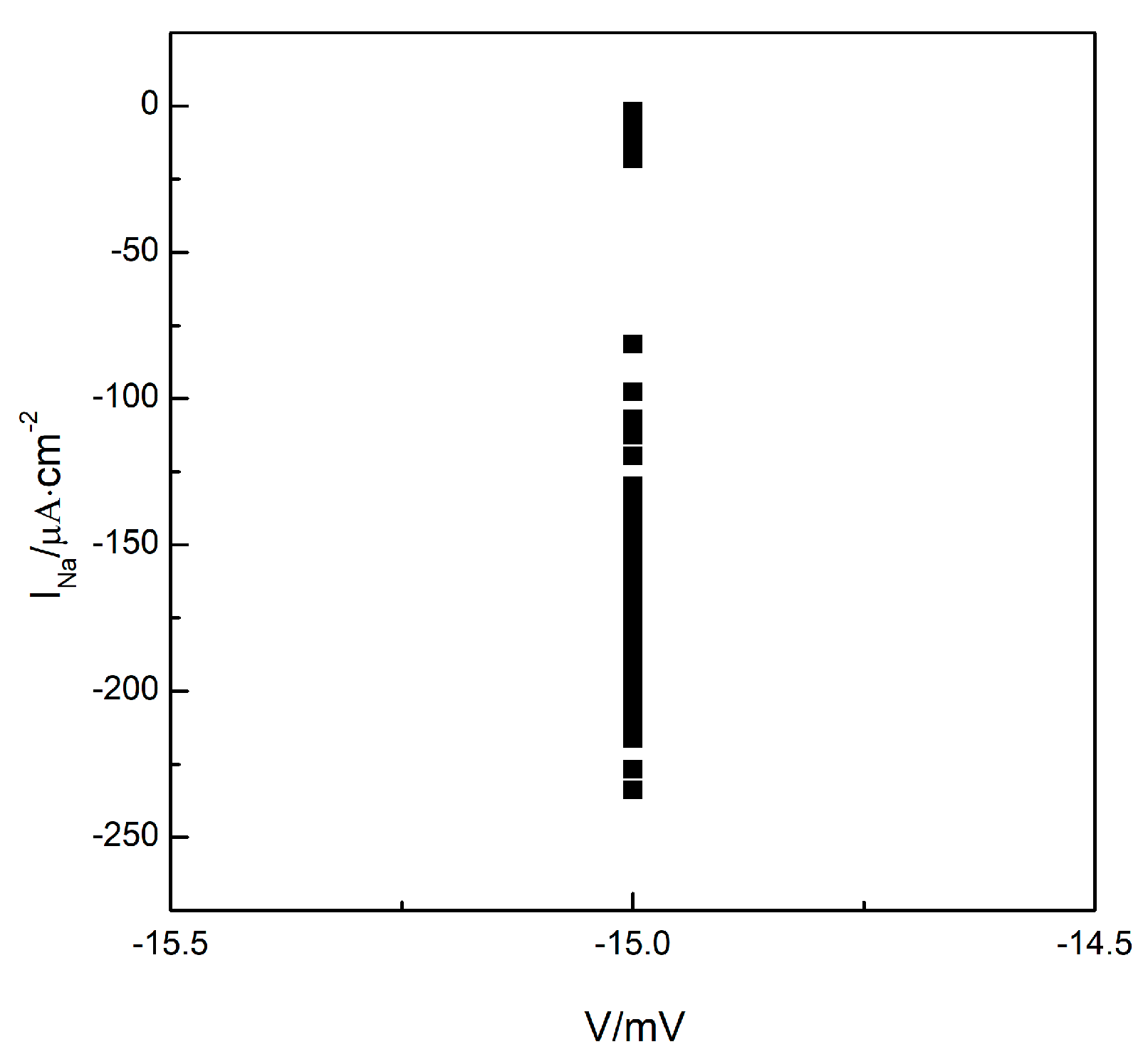

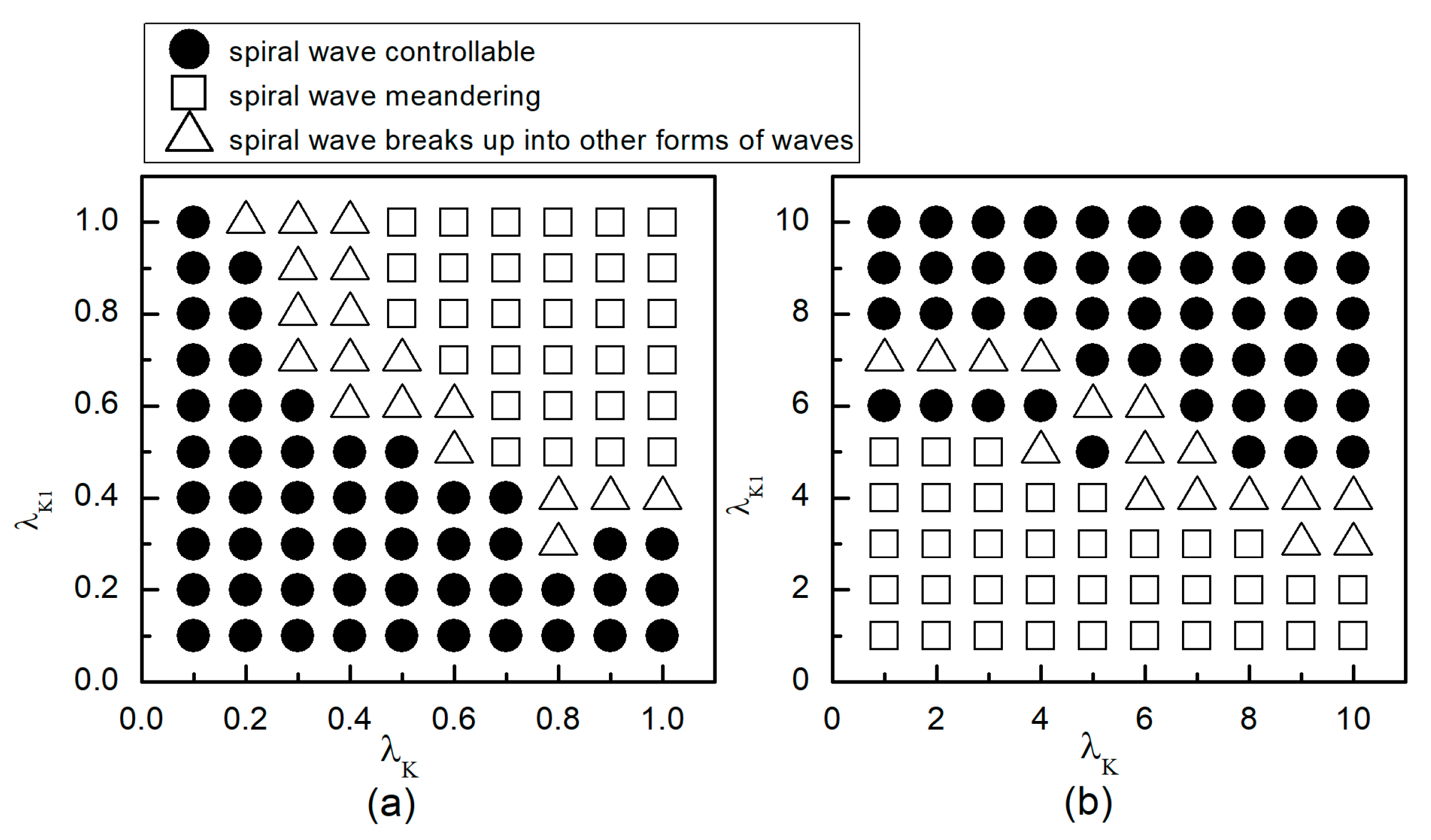
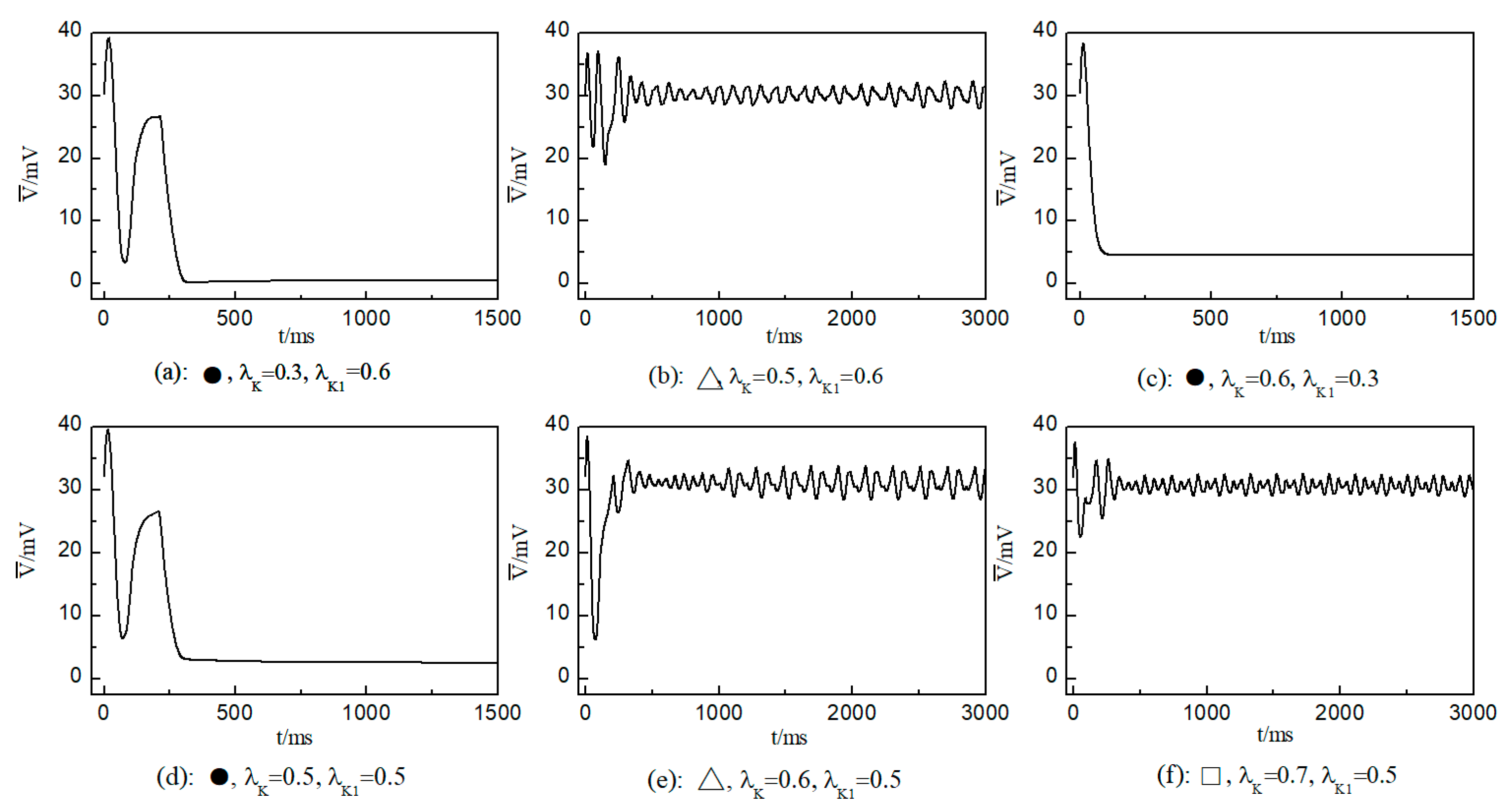

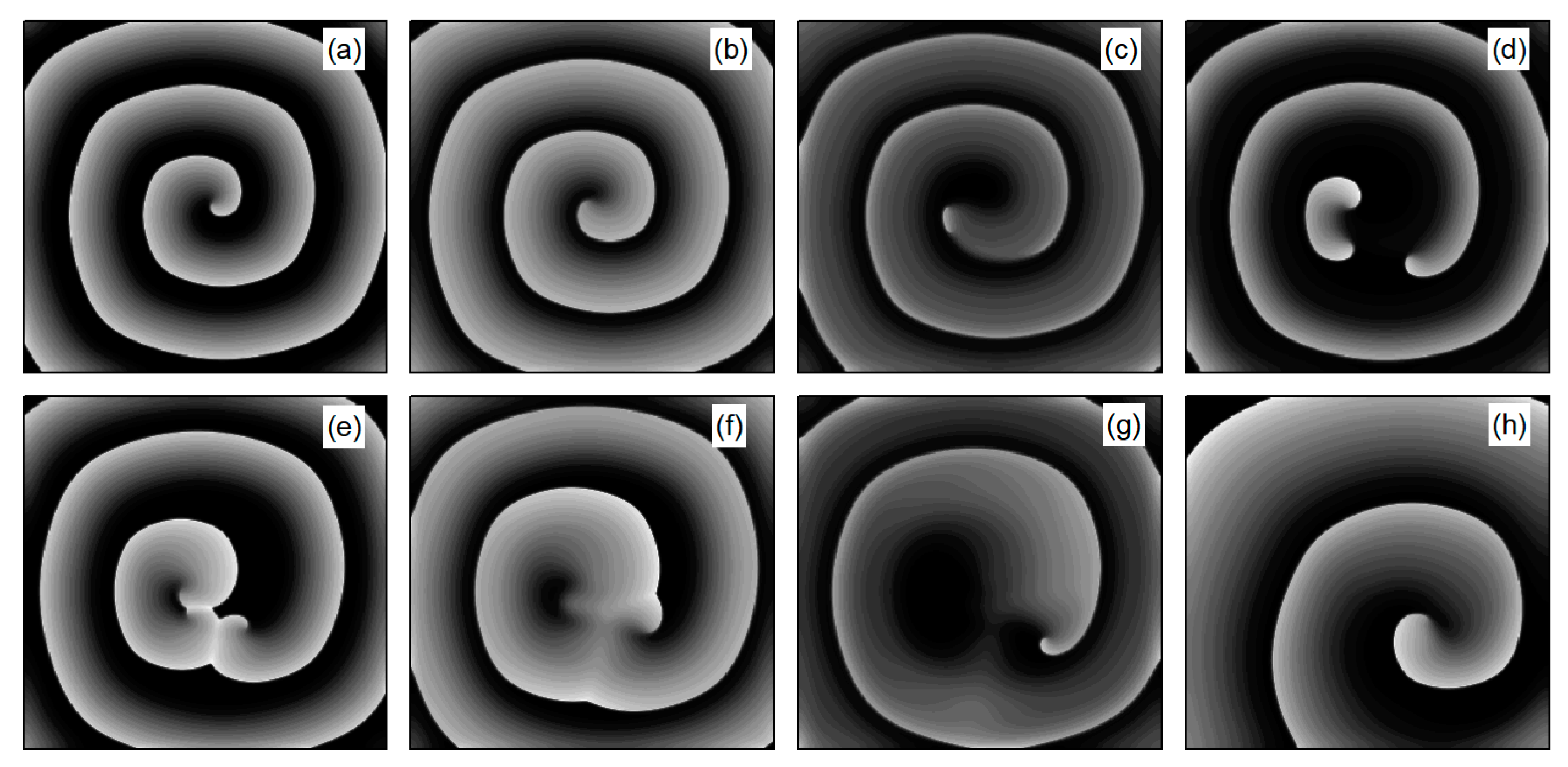

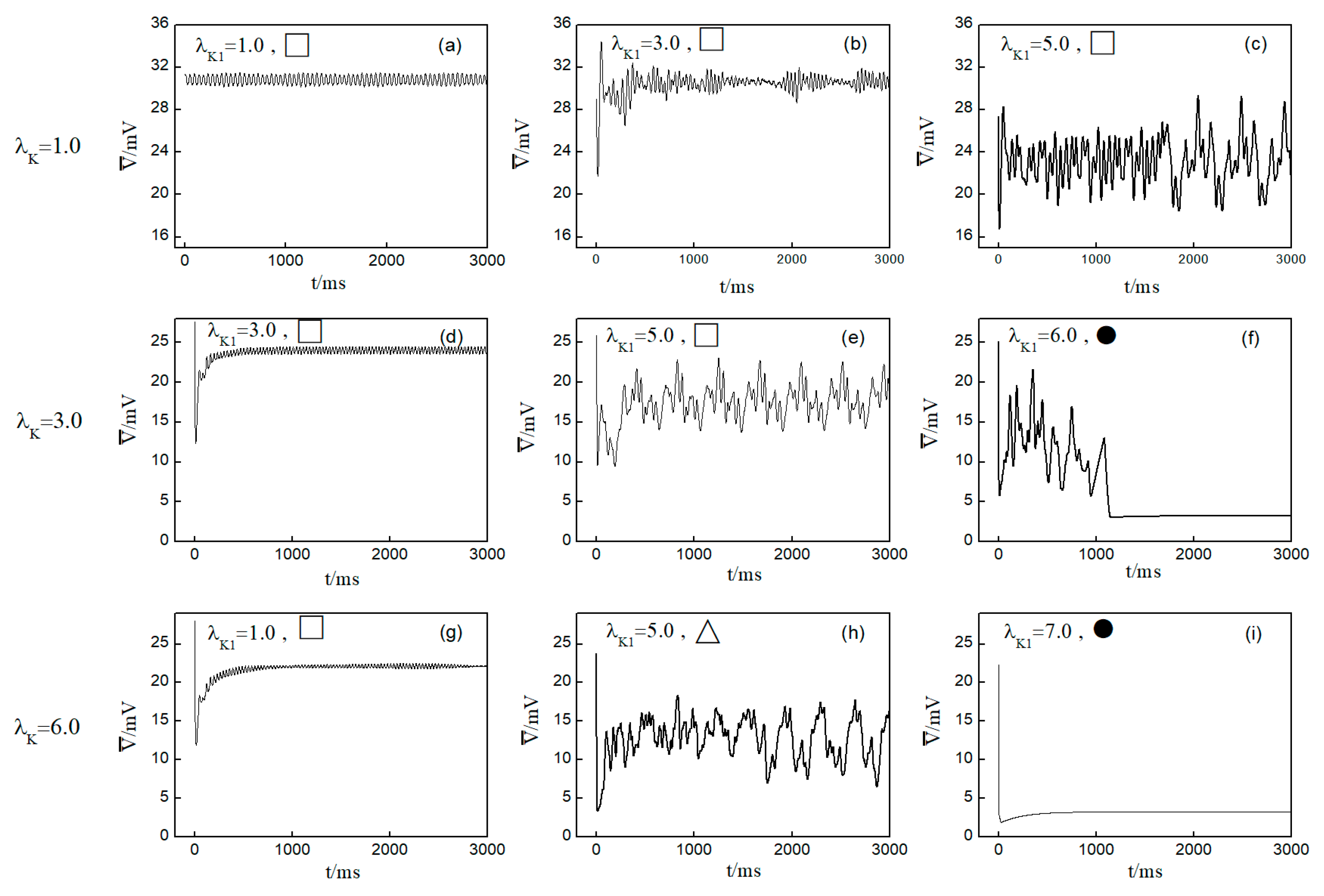
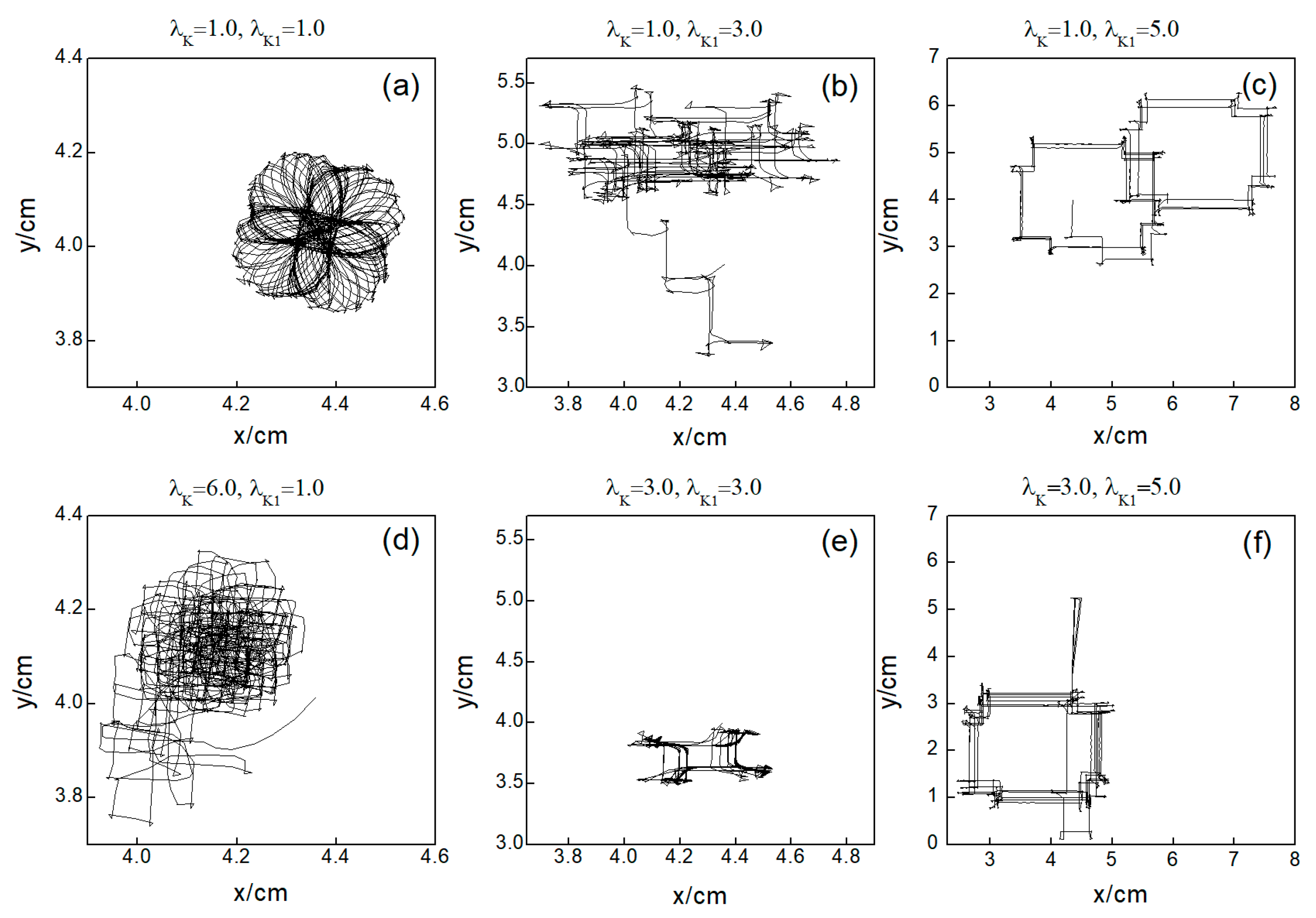
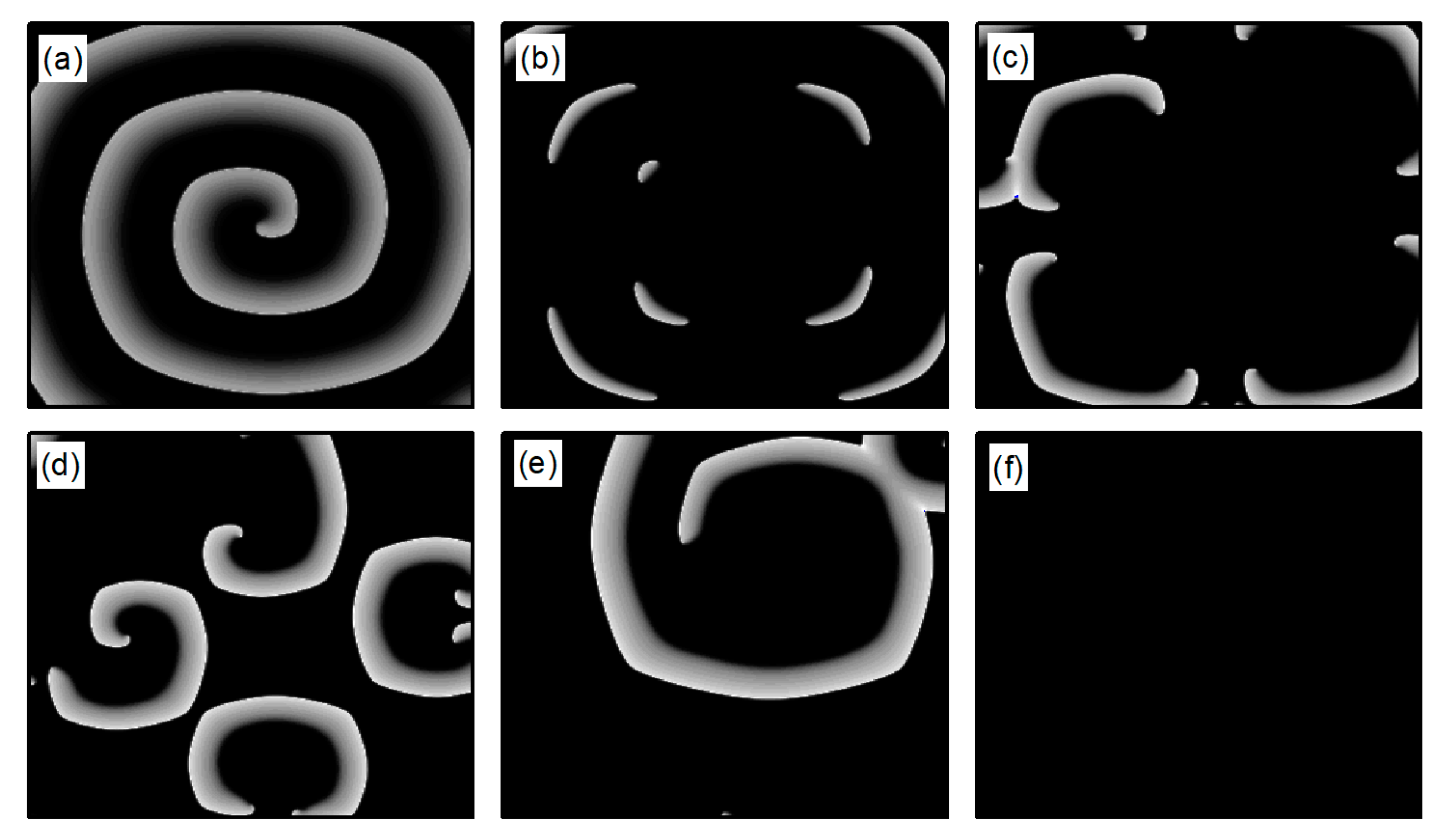
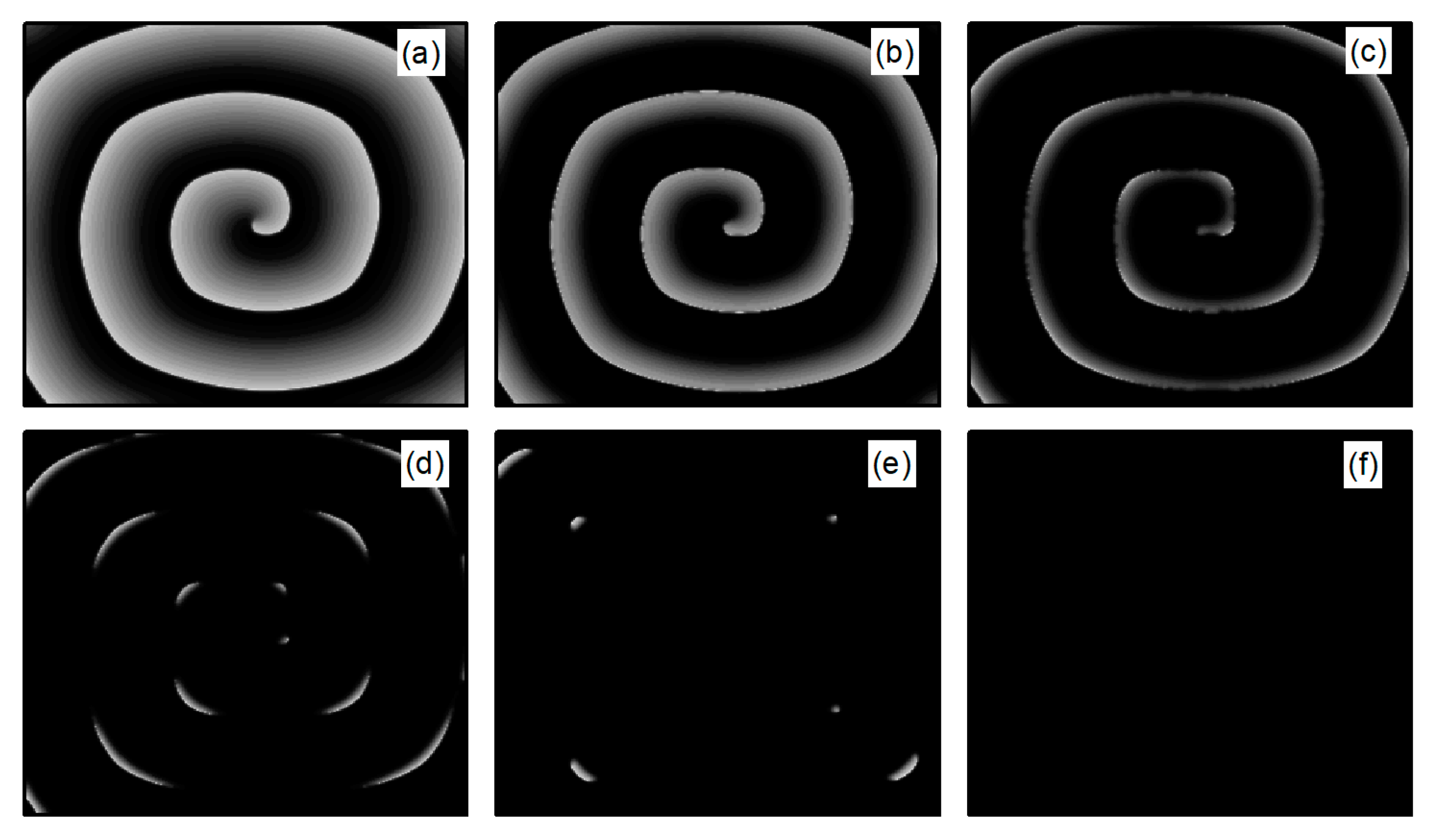
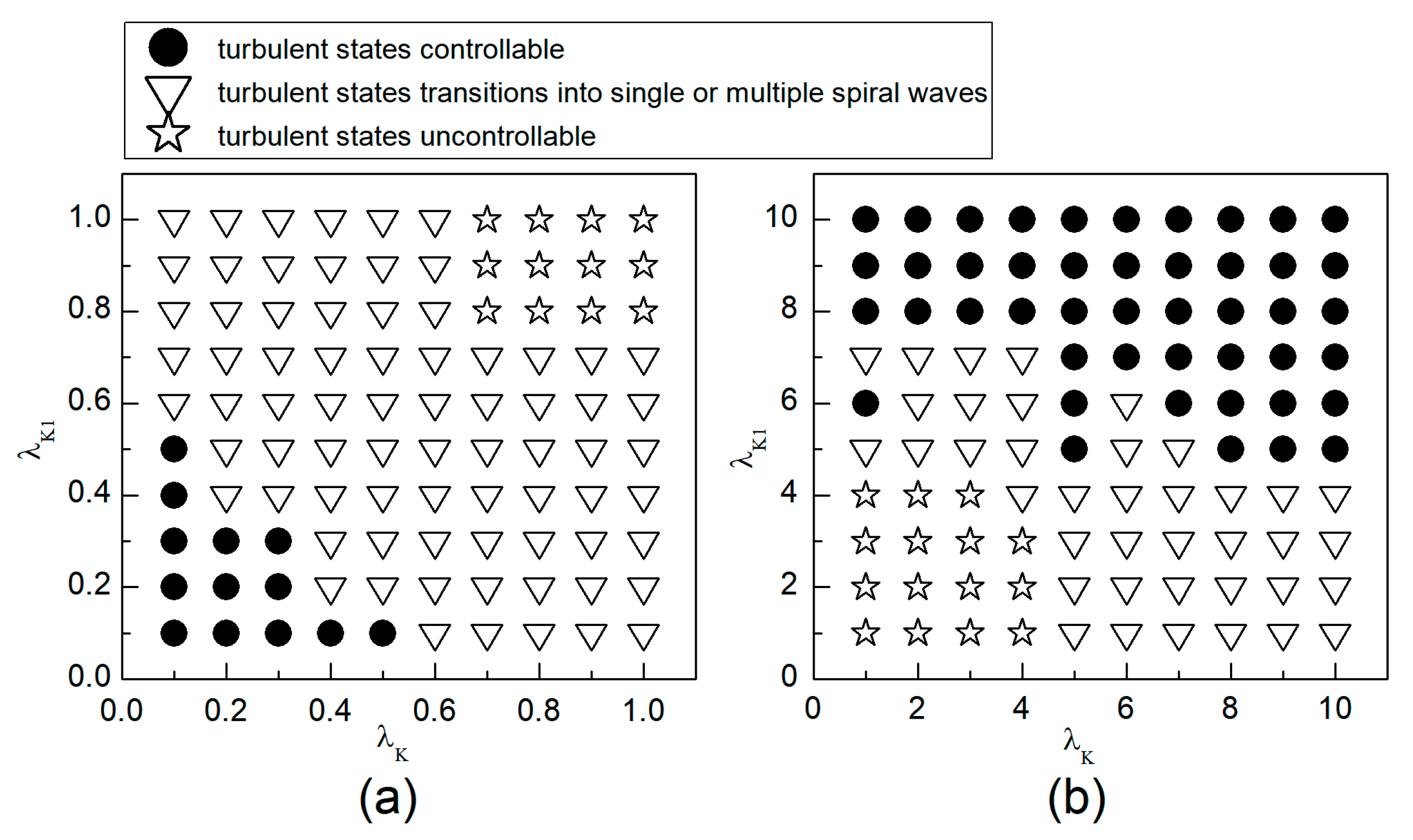


| Ion Current Expression | Ion Current Meaning |
|---|---|
| the fast inward sodium ion current | |
| the slow inward calcium ion current | |
| the time-dependent potassium current | |
| the time-independent potassium current | |
| the plateau potassium current | |
| the background leakage current |
Disclaimer/Publisher’s Note: The statements, opinions and data contained in all publications are solely those of the individual author(s) and contributor(s) and not of MDPI and/or the editor(s). MDPI and/or the editor(s) disclaim responsibility for any injury to people or property resulting from any ideas, methods, instructions or products referred to in the content. |
© 2024 by the authors. Licensee MDPI, Basel, Switzerland. This article is an open access article distributed under the terms and conditions of the Creative Commons Attribution (CC BY) license (https://creativecommons.org/licenses/by/4.0/).
Share and Cite
Bai, J.; Zhang, C.; Liang, Y.; Tavares, A.; Wang, L. Impact of Combined Modulation of Two Potassium Ion Currents on Spiral Waves and Turbulent States in the Heart. Entropy 2024, 26, 446. https://doi.org/10.3390/e26060446
Bai J, Zhang C, Liang Y, Tavares A, Wang L. Impact of Combined Modulation of Two Potassium Ion Currents on Spiral Waves and Turbulent States in the Heart. Entropy. 2024; 26(6):446. https://doi.org/10.3390/e26060446
Chicago/Turabian StyleBai, Jing, Chunfu Zhang, Yanchun Liang, Adriano Tavares, and Lidong Wang. 2024. "Impact of Combined Modulation of Two Potassium Ion Currents on Spiral Waves and Turbulent States in the Heart" Entropy 26, no. 6: 446. https://doi.org/10.3390/e26060446
APA StyleBai, J., Zhang, C., Liang, Y., Tavares, A., & Wang, L. (2024). Impact of Combined Modulation of Two Potassium Ion Currents on Spiral Waves and Turbulent States in the Heart. Entropy, 26(6), 446. https://doi.org/10.3390/e26060446





